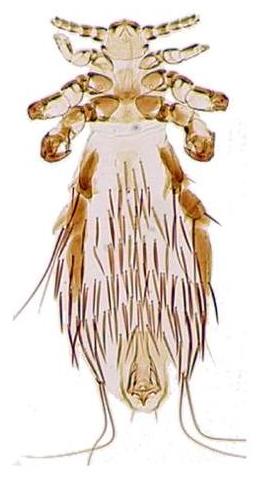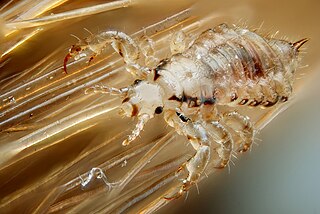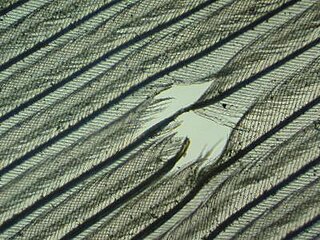
Louse is the common name for any member of the clade Phthiraptera, which contains nearly 5,000 species of wingless parasitic insects. Phthiraptera has variously been recognized as an order, infraorder, or a parvorder, as a result of developments in phylogenetic research.

The Mallophaga are a possibly paraphyletic section of lice, known as chewing lice, biting lice, or bird lice, containing more than 3000 species. These lice are external parasites that feed mainly on birds, although some species also feed on mammals. They infest both domestic and wild mammals and birds, and cause considerable irritation to their hosts. They have paurometabolis or incomplete metamorphosis.

The genus Haematomyzus includes three species of lice that differ so markedly from all other lice that the genus is placed in its own family Haematomyzidae, itself monotypic within the superfamily Rhynchophthirina. These unusual lice are ectoparasites of elephants and warthogs. Their mouthparts are elongated to form a drill-like structure that allows them to penetrate the thick skin of their host.

The Amblycera are a large clade of chewing lice, parasitic on both birds and mammals. The Amblycera are considered the most primitive clade of lice.

The head louse is an obligate ectoparasite of humans. Head lice are wingless insects that spend their entire lives on the human scalp and feed exclusively on human blood. Humans are the only known hosts of this specific parasite, while chimpanzees and bonobos host a closely related species, Pediculus schaeffi. Other species of lice infest most orders of mammals and all orders of birds.
A bird louse is any chewing louse of order Phthiraptera which parasitizes warm-blooded animals, especially birds. Bird lice may feed on feathers, skin, or blood. They have no wings, and their biting mouth parts distinguish them from true lice, which suck blood.

The snow partridge is a gamebird in the pheasant family Phasianidae found widely distributed across the high-altitude Himalayan regions of Pakistan, China, India and Nepal. It is the only species within its genus, and is thought to be the most basal member of the "erectile clade" of the subfamily Phasianinae. The species is found in alpine pastures and open hillside above the treeline but not in as bare rocky terrain as the Himalayan snowcock and is not as wary as that species. Males and females look similar in plumage but males have a spur on their tarsus.

The body louse is a hematophagic ectoparasite louse that infests humans. It is one of three lice which infest humans, the other two being the head louse, and the crab louse or pubic louse.

Haematopinus is a genus of insects in the superfamily Anoplura, the sucking lice. It is the only genus in the family Haematopinidae, known commonly as the ungulate lice. All known species are of importance in veterinary medicine. These lice are some of the most economically important ectoparasites of domestic animals. Species infest many domesticated and wild large mammals, including cattle, horses, donkeys, swine, water buffalo, African buffalo, antelope, zebra, deer, and camels. The species Haematopinus tuberculatus has great importance in the water buffalo breading, since this louse is specific to buffaloes, being the main ectoparasite of the species, with important sanitary and economic burden. The Haematopinus tuberculatus is suspected to be involved in the transmission of diseases, such as anaplasmosis. The parasites are found infesting buffaloes in greater concentrations around the ears, base of horns, side of the neck, around the scrotum or udder, and especially at the tip of the tail.
The Laemobothriidae are a family of a larger group Amblycera of the chewing lice. Most commonly they are ectoparasites of birds. The genera are sometimes all united in Laemobothrion.

Feather holes often characteristically occur on wing and tail feathers of some small-bodied species of passerines. In the case of barn swallows, it was suggested that the holes were feeding traces of avian lice, either Machaerilaemus malleus and/or Myrsidea rustica.

Menacanthus is a genus of chewing lice which parasitise birds. The taxonomy of this genus is highly uncertain. Most taxonomies have given this genus as having over a hundred species, but recent studies have synonymised dozens of species and found other names to be invalid. Some Menacanthus species remain to be discovered, or are synonymised in error. Menacanthus lice feed on the blood of a wide variety of birds, including chickens, by piercing the quills of feathers and gnawing the epidermis. In doing so, they can spread disease and lower egg production. In Menacanthus stramineus, eggs are incubated for four or five days, each of the three nymphal stages lasts for about three days, and adult life for about twelve days. Females produce as many as four eggs in a day, averaging 1.6 eggs a day, with egg production peaking 5–6 days after reaching adulthood. On sparrows, Menacanthus lice are particularly common, and are found in many different niches, consuming blood and feathers.

Trichodectes canis, also known as canine chewing louse, is a chewing louse found on domesticated dogs and wild canids throughout the world. T. canis is a well-known vector for the dog tapeworm, Dipylidium caninum. T. canis usually does not present any major problems to the host, however, can be very irritating in heavy infestations. In North America and most developed countries, T. canis infestation of domesticated dogs is very uncommon as long as they are properly cared for and healthy. Poorly taken care of dogs are more prone to getting a lice infestation.

Solenopotes capillatus is known as the little blue cattle louse in the United States and the tubercle-bearing louse in Australia. This louse is the smallest of the sucking lice that occur on cattle and is a relatively immobile species. They are found all around the world in distribution but are restricted mainly to areas with domestic livestock. The little blue cattle louse is most often found on the head of its host, primarily the face and jaw region, but sporadically is found on other body parts. It is relatively immobile so typically will not relocate on its host's body. The louse is spread by direct contact and is considered an ectoparasite.

Mites are small crawling animals related to ticks and spiders. Most mites are free-living and harmless. Other mites are parasitic, and those that infest livestock animals cause many diseases that are widespread, reduce production and profit for farmers, and are expensive to control.

The Ricinidae are a family of a larger group Amblycera of the chewing lice. All species are relatively large bodied avian ectoparasites. They typically exhibit low prevalence and low intensity. They feed on host blood which is atypical in chewing lice. Two or three genera are recognized.

Colpocephalum is a genus of chewing louse. Christian Ludwig Nitzsch named the genus in 1818. The Plenary Powers of the International Commission on Zoological Nomenclature selected Colpocephalum zebraBurmeister, 1838 as its type species in the 1950s. There are approximately 135 species in this genus, and they are ectoparasites of birds in at least a dozen different orders.

Apterygon is a genus of louse. It is endemic to New Zealand and is an ectoparasite of kiwi birds (Apteryx). Theresa Clay circumscribed the genus in 1961. In 1947, she had referred to this genus as "New Genus D", but it was not formally named as she needed to confirm the host of her specimen as well as additional material.

Actornithophilus is a genus of louse in the family Amblycera. It was circumscribed by Gordon Floyd Ferris in 1916. Its species are ectoparasites of birds in the order Charadriiformes.

Harrison's rule is an observation in evolutionary biology by Launcelot Harrison which states that in comparisons across closely related species, host and parasite body sizes tend to covary positively.
















